Search the Special Collections and Archives Portal
Search Results
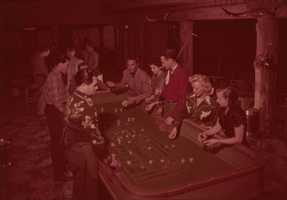
Film transparency of gamblers at a craps table in the Hotel Last Frontier (Las Vegas), 1950-1959
Date
Archival Collection
Description
Gamblers playing craps. The gambler playing craps has $350 in his hand.
Site Name: Frontier
Address: 3120 Las Vegas Boulevard South
Image
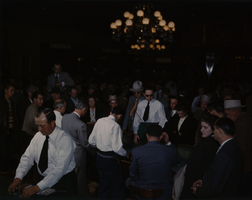
Film transparency of gamblers playing craps at the Golden Nugget Gambling Hall (Las Vegas), circa 1950s
Date
Archival Collection
Description
Gamblers at a craps table at the Gambling Nugget Gambling Hall.
Site Name: Golden Nugget Las Vegas
Address: 129 East Fremont Street
Image
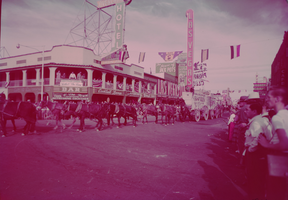
Film transparency of the Helldorado Parade near the Overland Hotel and Las Vegas Club on Fremont Street (Las Vegas), circa 1950s
Date
Archival Collection
Description
The Helldorado Parade in front of the Overland Hotel on Main and Fremont and the Las Vegas Club. Helldorado is an annual parade that celebrates Las Vegas' western history.
Site Name: Fremont Street
Address: Fremont street, Las Vegas, NV
Image
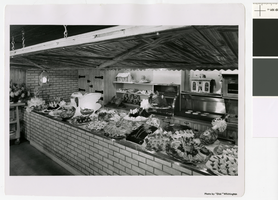
Photograph of the Chuck Wagon Buffet at the El Rancho Vegas (Las Vegas), circa 1953
Date
Archival Collection
Description
The Chuck Wagon Buffet in the El Rancho Vegas with an assortment of food and an ice sculpture of a swan.
Site Name: El Rancho Vegas
Address: 2500 Las Vegas Boulevard South
Image
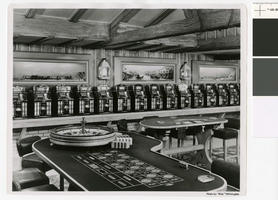
Photograph of the casino area of the El Rancho Vegas (Las Vegas), circa 1953
Date
Archival Collection
Description
Table games and slots in the El Rancho Vegas casino
Site Name: El Rancho Vegas
Address: 2500 Las Vegas Boulevard South
Image
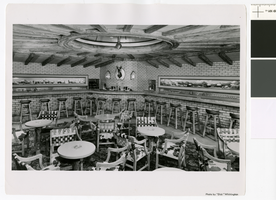
Photograph of the cocktail lounge at the El Rancho Vegas (Las Vegas), circa 1953
Date
Archival Collection
Description
Site Name: El Rancho Vegas
Address: 2500 Las Vegas Boulevard South
Image
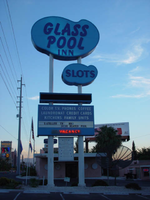
Photographs of Glass Pool Inn signs, Las Vegas (Nev.), 2002
Date
Archival Collection
Description
Site address: 4613 S Las Vegas Blvd
Sign details: Located on the very south end of Las Vegas Blvd the Glass Pool Inn boasts a Pylon/Pole sign along the east side of the Strip. Both the sign and the adjacent lounge, which holds vestiges of wall signs, are directly Northwest of the famed glass Portaled pool, where the establishment takes its name.
Sign condition: Structure 3 Surface 2 Lighting 2
Sign form: Pylon
Sign-specific description: The Glass Pool's main sign is a double-backed, double poled, internally lit pylon design. The top portion, a sculpted internally lit marquee in the classic kidney pool shape, reads "Glass Pool Inn." A smaller sign of similar water referenced design, sits below the main marquee. They are both contained in sheet metal framed painted blue. The bottom portion is comprised of a incandescent bulb LED matrix center, a Sheet metal message center containing a small plastic readerboard with vinyl letters, and a red neon sign for vacancy. The boxes or the message centers are also blue sheet metal.
Sign - type of display: Neon; Incandescent; Backlit
Sign - media: Steel; Plastic
Sign - non-neon treatments: Paint
Sign animation: none
Sign environment: The Glass Pool Inn sits on south end of the strip among the small dying hotels of Las Vegas Blvd's earlier history, it is one of the first signs you see traveling North on the strip entering town. Just north lies the beginning of the main flood of architecture from the modern strip; while to its south are the beginnings of the strip and the spawning new growth of Las Vegas. The Glass Pool stands in the unique position of being in that gateway of entering the Las Vegas Strip
Sign manufacturer: YESCO
Sign - date of installation: 1953
Sign - date of redesign/move: In 1989 when Steve Wynn was establishing the Mirage, there was another property which also had the name: the small southern Strip, roadside motel. When Wynn acquired the name the original Mirage simply changed its name to the Glass Pool Inn. The original sign was left in place, and simply remodeled to fit the new name of the motel. Permitted by the county to refurbish in December of 1988.
Sign - thematic influences: Water and the pool itself, kidney-shaped design.
Sign - artistic significance: The Glass Pool is an artistic artifact of the older smaller strip hotels. Artistically it is reminiscent of the roadside pole sign used to attract traffic. It represents one of the last strip roadside motels in that portion of the Strip.
Surveyor: Joshua Cannaday
Survey - date completed: 2002
Sign keywords: Pylon; Neon; Incandescent; Backlit; Steel; Plastic; Paint
Mixed Content
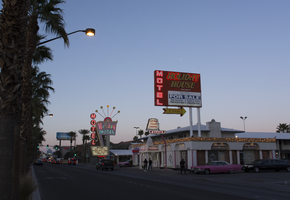
Photographs of Holiday House Motel sign, Las Vegas (Nev.), March 1, 2017
Date
Archival Collection
Description
Site address: 2211 S Las Vegas Blvd
Sign details: The Holiday House Motel was originally the Bagdad Inn that opened up in the 1950's. The actual motel was possibly named after Bagdad California, a small ghost town in the San Bernardino county. This town was a former route 66 pit stop and later passed by with the new I-15 and I- 40 in the late 1970's. The motel changed its name in 1983 to Holiday House Motel. The motel currently has a for sale sign.
Sign condition: The sign is in a 4.5. There seems to not have much sun or wind damage to the sign. The color is still fresh.
Sign form: This is a two- pole squared structured sign.
Sign-specific description: The sign is a bright red squared basis. All aspects of the sign's advertisement are connected together in one large square. There is no separation within the structure; it just looks like one giant red canvas with words and would even suggest the sign is very minimal. At the bottom, right portion of the sign you will see a small reader board (currently the reader board has been covered with a for sale sign). Vertically on the left side is the word motel in white lettering. The holiday house font is in yellow incandescent lighting, and the font looks italicized. The no vacancy is in neon underneath the holiday house typography. Two white poles are what holds up the sign.
Sign - type of display: Neon, Incandescent and fluorescent lighting.
Sign - media: Steel and Plastic
Sign - non-neon treatments: Reader board
Sign animation: Flasher for the incandescent light bulbs in the letters
Sign environment: This location is on the north end of the Strip across the street from the Stratosphere and near the Holiday Motel and Fun City Motel.
Sign - date of installation: 1983
Sign - date of redesign/move: In 1950's the sign was Bagdad Inn and in 1983 the establishment later changed into the Holiday House Motel.
Sign - thematic influences: This sign could have inspiration from the post modernism idea of open space and minimal design to "advertise" to consumers. This sign is very representative of 1970's designs.
Sign - artistic significance: Every portion of the sign was thoughtfully placed to hit the consumer in a fast and efficient way.
Survey - research locations: Vintage Vegas http://vintagelasvegas.com/search/Holiday+House+Motel and Roadside Architecture http://www.roadarch.com/signs/nvvegas.html .
Surveyor: Gisselle Tipp
Survey - date completed: 2017-08-30
Sign keywords: Neon; Incandescent; Steel; Plastic; Flashing; Reader board; Pole sign; Fluorescent; Roof Sign
Mixed Content

Transcript of interview with Randall "Randy" Walker by Stefani Evans, November 2, 2017
Date
Archival Collection
Description
In twenty-first-century, urban America, Randall "Randy" Walker is one of the few fathers who can say he raised his children in the same house in which he grew up. Walker did not inherit the house at 443 Republic Street, in Henderson. Instead, Walker bought the house from his parents after he graduated from Brigham Young University in Utah, worked with Exxon Oil Company in Houston, returned to Southern Nevada to work in his first government job as a budget analyst for Clark County, and sold the house he previously owned. He did not have to move his wife and children far-their previous home was at 442 Republic Street, directly across from his parents. In this oral history, Walker shares why his family came to Henderson in 1952, describes growing up in the small town of his youth, and tells what it was like to have his father as his high school Spanish teacher. He focuses on his career in government and how he applied his accountant mindset to the various positions he held with Clark County, the Las Vegas Metropolitan Police Department, the City of Las Vegas, and McCarran Airport. Along the way he shares his experiences with large governmental building projects such as the first 911 Call Center, the Downtown Transportation Center, the Regional Justice Center, and at McCarran Airport, the D v Gates, Terminal 3, and the airport tunnel and connector roads. He explains how his work with these various projects brought him into interaction with such diverse fields as architecture, accounting, construction, design, infrastructure, public art, public safety and local, state, and national politics. Throughout, Walker displays the collegial and common-sense approach to government, leadership, and problem solving that grounds the decisions he makes and explains why Richard Bunker wanted him at Clark County, why Clark County leaders recruited him to be county manager (and why that did not happen), and why McCarran Airport was able to accommodate without interruption Southern Nevada's record-breaking growth in residential and tourist traffic, and why, even in his absence, McCarran was the first major airport allowed to reopen following the 2001 September Eleventh terror attacks.
Text
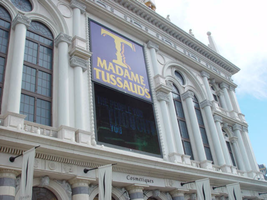
Photographs of Madame Tussaud's signs, Las Vegas (Nev.), 2002
Date
Archival Collection
Description
Site name: Venetian (Las Vegas, Nev.)
Site address: 3377 S Las Vegas Blvd
Sign details: Madame Tussaud's Wax Museum is located inside the Venetian Hotel and Casino. Located at the southern end of the property, it is tucked away at the end of a long stretch of escalators. Even though it is not in complete plain view, the facility is directly in the line of pedestrian traffic. The escalators serve as one of the main causeways into the Venetian for the traveler headed north on the east side of the strip. The facility is also advertised by an architecturally integrated building sign, and an LED screen that are in plain view from the street. A the end of the bay of escalators, a platform folds out, containing the vibrant entrance to the Wax Museum. Flanking the large opening designated as the entrance, are six free standing sculpted cabinet, advertising for Madame Tussaud's, lining up three on either side of the door. Standing underneath the entry, are a cast of ever rotating wax figures of celebrities. Just beyond the wax sentry, six more sculpted cabinets are present on other side of the pedestrian leading up to a ticket counter. On the ceiling above the pedestrian is an array of sculpted elements that are adorned with incandescent bulbs and neon, all leading up to the afore mentioned counter.
Sign condition: Structure 5 Surface 5 Lighting 5
Sign form: Fascia
Sign - type of display: Neon; Incandescent
Sign - media: Steel; Plastic
Sign - non-neon treatments: Graphics; Paint
Sign animation: Chasing
Sign environment: Madame Tussaud's holds the unique position of being elevated above the street, within the Venetian. Located at the top of a bank of escalators, the museum is positioned so that it is the dominating force upon the pedestrian with its immediate area. With careful examination it is evident that the it resides in the Venetian, but has tight hold on it's claim of space. Even though the location is somewhat hidden, it is a present force, and alongside a series of moving walk paths, generating a high frequency of vibration.
Sign manufacturer: YESCO
Sign - date of installation: 2000
Sign - thematic influences: The theme of Madame Tussaud's revolves around the theme of what the establishment provides. The main attraction is of course the lifelike imagery of celebrities sculpted in wax. The establishment draws from the theme of celebrities and stardom in design. The advertisement cabinets, which line the entry to Madame Tussaud's, are shaped to reference this. One set is crafted in the shape of a stylized star, while the others appear as street side movie posters seen in theatres or propaganda. The feel of them, to sum up initially, is classic "Hollywood" movie opening extravaganza. The star shapes and jutting channels on the ceiling of the entrance are other references to stars as well as the feel of electricity. These too can be associated with "movie star" like elements such as the Hollywood walk of fame, with it's star shaped crests, references to celebrities as "stars," as well as the a fore mentioned flavor of a movie opening or extravaganza.
Surveyor: Joshua Cannaday
Survey - date completed: 2002
Sign keywords: Chasing; Fascia; Neon; Incandescent; Steel; Plastic; Graphics; Paint
Mixed Content
